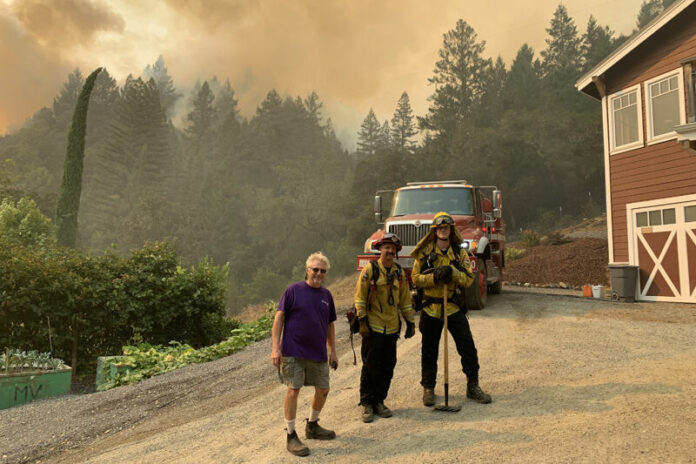Dry Creek, Russian River valleys filled with smoke and unpicked ripening grapes
Sonoma County’s 2020 winegrape harvest was already predicted to be an extra challenge from the added safety requirements for the COVID-19 pandemic, the uncertain economy and the recent years of declining tonnage prices due to a market glut. All that was before the LNU Lightning Complex fires began threatening winery properties west of Healdsburg and in the Russian River Valley and forcing thousands of workers and families to evacuate the area, with thousands more now waiting out evacuation warnings.
The early stages of the 2020 harvest started about three weeks ago when pinot noir and chardonnay grapes were picked for sparkling wine production. Then lightning sparks ignited hundreds of fires on Aug. 16 and 17 with the most threatening fire, the Walbridge Fire, now grown to over 50,000 acres and being fought by thousands of firefighters in the northwest forests and ridges above Guerneville, Rio Nido, Forestville and Dry Creek Valley.
Another fire, the Meyers Fire, is threatening wineries and vineyards on the Sonoma Coast north of Jenner and inland from Timber Cove.
Dozens of wineries lay along the periphery of the fire zones along River Road, Westside Road and in western Dry Creek Valley. Guerneville’s Korbel Winery ceased production work last Wednesday and diverted ripening grapes to its Bakersfield Heck Cellars. Elsewhere, the dangerous smoke-filled air has halted grape picking until the skies clear, but then face masks will still be required because of the coronavirus pandemic. Some harvest activity is continuing where crushed juice is already in tanks and winery crews are performing emergency preparations and operations.
Last Wednesday when the first mandatory evacuation orders were made, Rick Moshin and his crew were in the middle of crushing four tons of sauvignon blanc grapes. “The grapes won’t wait. All the recent heat ripened them early and we had no choice,” he said. Moshin Winery is located in the 10,000 block of Westside Road, a mile downriver from Wohler Bridge. On the same day, a crew of pickers were harvesting chardonnay grapes at Rochioli Vineyards, four miles to the north.
Moshin said future harvest plans would be determined by air quality and worker safety. “We were already facing all the heat and now this. For us, it’s just day-by-day,” he said. Moshin almost lost his residence on Sweetwater Springs Road when three fire crews responded and knocked down approaching flames and established a safe perimeter.
Each of the past wildfires from 2017 and 2019 left scars and economic impacts on the local wine industry and workers. The green vines and lush canopies do not burn as much as forests or dry brush and act as firebreaks in many terrains. The greater risks and impacts from wildfires is the loss of winery buildings, displaced workers and the unfortunate national media coverage that keeps tourists away and some wine buyers leery of “smoke-tainted” wines.
Karissa Kruse, president of the Sonoma County Winegrowers lost her Santa Rosa house in the 2017 Tubbs Fire. “I lost my house but I am proof that you can recover. We’ve learned to work together and be resilient. We want it that way because we love it here,” she said. So far, the wildfires have stayed in the more rugged hills and forests away from the vineyards and valley winery properties. Separate fires are also threatening Napa Valley wineries.
“Overall in terms of timing, the harvest started early this year, about 10 days. Grape growers have been mainly harvesting Chardonnay and Pinot Noir for sparkling wines so far and have been waiting for the brix to increase for still wines and the wildfires are catching us in between these two harvest cycles,” said Kruse. “It is way too early to know if there will be any impact on the grape harvest and quality. Our grape growers are vigilant about farming the highest quality of grapes they can.”
In the coming days “safety is our number one priority,” said Kruse. “We have been concerned about our farmworkers who may have been evacuated or not able to work so we just re-opened our farmworker resiliency fund through the Sonoma County Grape Growers Foundation.” She said the first application came in in just 12 hours.
The fund supported over 1,500 farmworker families after the 2017 and 2019 wildfires, providing rent support, temporary housing, food allowances and other relocation expenses. Applications are now being accepted at their website (www.scggf.org/fire-recovery-support.)
54.1
F
Healdsburg
November 17, 2024








